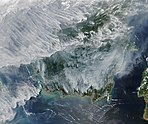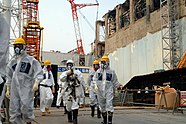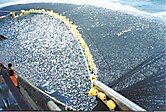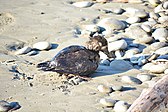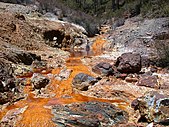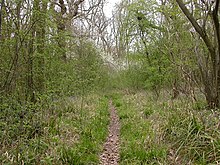환경문제
Environmental issues이 글의 예시와 관점은 주제에 대한 전세계적인 관점을 나타내지 않을 수 있습니다.에 따라 본 하거나 에서 를 수 있습니다. (2020년 3월) ( 메시지 및 알아보기 |
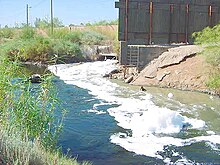
환경 문제는 생태계의 일상적인 기능을 방해하는 것입니다.[1]또한, 이러한 문제들은 인간에 의해 야기될 수도 있고 (환경에 대한 인간의 영향)[2] 자연적일 수도 있습니다.이러한 문제는 현재 상황에서 생태계가 회복될 수 없을 때 심각하고 생태계가 확실히 붕괴될 것으로 예상되는 경우 재앙적인 것으로 간주됩니다.
환경보호(Environmental protection)는 환경과 인간 모두의 이익을 위해 개인, 조직 또는 정부 차원에서 자연환경을 보호하는 행위입니다.환경주의(Environmentalism)는 사회적, 환경적 운동으로 환경 문제를 해결하기 위해 옹호, 입법 교육, 행동주의를 통해 노력하는 운동입니다.[3]
인간에 의한 환경 파괴는 전 세계적이고 지속적인 문제입니다.[4]수질 오염은 해양 생물에게도 문제를 일으킵니다.[5]대부분의 학자들은 만약 인간 사회가 행성의 경계 내에서 지속 가능하게 살기 위해 노력한다면, 90억에서 100억 사이의 세계 최고 인구 프로젝트는 지구의 생태계 내에서 지속 가능하게 살 수 있을 것이라고 생각합니다.[6][7][8]환경에 미치는 영향의 대부분은 세계에서 가장 부유한 사람들의 과도한 산업재 소비로 인해 발생합니다.[9][10][11]UN 환경 프로그램은 2021년 "자연과 평화를 이루다" 보고서에서 오염, 기후 변화 및 생물 다양성 손실과 같은 주요 행성 위기를 해결하는 것이 지속 가능한 개발 목표를 해결하기 위해 당사자들이 노력한다면 가능하다는 것을 발견했습니다.[12]
종류들
현재 주요한 환경문제로는 기후변화, 오염, 환경파괴, 자원 고갈 등이 있습니다.보호 운동은 멸종 위기에 처한 종들을 보호하고 생태학적으로 가치 있는 자연 지역을 보호하기 위해 로비를 벌이고 있습니다.]] 유전자 변형 식품과 지구 온난화.유엔체제는 기후변화, 오염, 생물다양성 상실의 세 가지 주요 이슈에서 환경문제에 대한 국제적 틀을 채택하고 있습니다.[13]
인체영향
| 시리즈의 일부(on) |
| 사회학 |
|---|
 |
인간이 환경에 미치는 영향(또는 인위적 환경 영향)은 생물물리적 환경[14] 및 인간에 의해 직간접적으로 유발된 생태계, 생물 다양성 및 천연자원에[15] 대한 변화를 말합니다.(건설된 환경과 같이) 환경을 사회의 필요에 맞게 수정하는 것은 지구 온난화,[14][18][19] (해양 산성화와[14][20] 같은) 환경 악화[14], 대량 멸종 및 생물 다양성 손실,[21][22][23][24] 생태 위기 및 생태 붕괴를 포함한 심각한 영향을[16][17] 초래하고 있습니다.전 세계적으로 환경에 (직접적 또는 간접적으로) 피해를 주는 인간의 활동에는 인구 증가,[25][26][27] 신자유주의적 경제 정책[28][29] 및 급속한 경제 성장,[30] 과소비, 과잉 착취, 오염, 삼림 벌채 등이 포함됩니다.지구 온난화와 생물 다양성 손실을 포함한 문제들 중 일부는 인류의 생존에 대한 재앙적인 위험을 나타내는 것으로 제안되어 왔습니다.[31][32]
인위적이라는 용어는 인간의 활동으로 인해 발생하는 효과 또는 물체를 의미합니다.이 용어는 러시아 지질학자 알렉세이 파블로프(Alexey Pavlov)에 의해 기술적인 의미로 처음 사용되었으며, 영국 생태학자 아서 탄슬리(Arthur Tansley)에 의해 클라이맥스 식물 군집에 대한 인간의 영향을 언급하면서 영어로 처음 사용되었습니다.[33]대기 과학자 폴 크루첸(Paul Crutzen)은 1970년대 중반 "인류세"라는 용어를 소개했습니다.[34]이 용어는 때때로 농업 혁명이 시작된 이래로 인간의 활동으로 인해 발생한 오염의 맥락에서 사용되기도 하지만 또한 인간이 환경에 미치는 모든 주요한 영향에 광범위하게 적용됩니다.[35][36][37]인간이 가열된 환경에 기여하는 많은 행동들은 전기, 자동차, 비행기, 우주 난방, 제조업, 또는 숲 파괴와 같은 다양한 원천들에서 화석 연료를 태우는 것에서 비롯됩니다.[38]퇴화
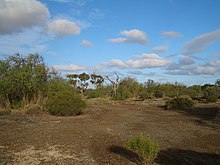
환경 악화는 대기, 물, 토양의 질과 같은 자원의 고갈, 생태계 파괴, 서식지 파괴, 야생동물의 멸종, 오염 등으로 환경이 악화되는 것입니다.유해하거나 바람직하지 않다고 인식되는 환경에 대한 모든 변화 또는 방해로 정의됩니다.[39]
환경에 대한 우려는 인간의 어떤 활동이 환경에 미치는 부정적인 영향으로 정의될 수 있습니다.생물학적 특징과 환경의 물리적 특징이 포함되어 있습니다.대기오염, 수질오염, 자연환경오염, 쓰레기오염 등이 주요 환경문제로 대두되고 있습니다.[40]
환경 악화는 유엔의 위협, 도전, 변화에 관한 고위급 패널이 공식적으로 경고한 10가지 위협 중 하나입니다.유엔 국제 재해 감소 전략은 환경 악화를 "사회적, 생태적 목적과 필요를 충족시키기 위한 환경의 용량 감소"로 정의하고 있습니다.[41]환경 악화는 여러 가지 유형으로 나타납니다.자연 서식지가 파괴되거나 천연자원이 고갈되면 환경이 악화됩니다.이 문제를 해결하기 위한 노력으로는 환경 보호와 환경 자원 관리가 있습니다.또한 환경을 잘못 관리한 세력에 대항하여 공동체가 조직을 구성하는 환경 갈등을 초래할 수 있습니다.갈등.
| 시리즈의 일부(on) |
| 환경정의 |
|---|
 |
| |
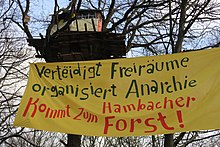
환경 갈등 또는 생태적 분배 갈등(EDCs)은 환경 악화 또는 환경 자원의 불평등한 분배로 인해 발생하는 사회적 갈등입니다.[42][43][44]환경 정의 아틀라스는 2020년 4월 현재 전 세계적으로 3,100건의 환경 분쟁을 문서화했으며 더 많은 분쟁이 문서화되지 않은 상태로 남아 있다고 강조했습니다.[42]이러한 분쟁과 관련된 당사자에는 지역의 영향을 받는 지역 사회, 주, 기업 및 투자자, 사회 또는 환경 운동 등이 포함됩니다.[45][46] 일반적으로 환경 보호자는 자원 추출이나 유해 폐기물 처리로부터 국토를 보호하고 있습니다.[42]자원 추출과 유해 폐기물 활동은 종종 자원 부족(예: 남획 또는 삼림 벌채)을 일으키고 환경을 오염시키며 인간과 자연의 생활 공간을 저하시켜 갈등을 초래합니다.[47]환경 갈등의 특별한 경우는 산림 갈등으로, 산림 정책 및 산림 자원의 사용과 관련된 가치 및 문제를 둘러싼 이익 집단 간의 다양한 강도의 투쟁으로 간주됩니다.[48]지난 수십 년 동안 전 세계적으로 이 중 점점 더 많은 수가 확인되었습니다.[49]
환경 갈등은 종종 환경 정의 문제, 원주민의 권리, 농민의 권리, 또는 생계가 해양에 의존하는 지역 사회에 대한 위협에 초점을 맞춥니다.[42]전 세계 환경 정의 운동을 구성하는 초국가적 환경 정의 네트워크는 지역 갈등의 결과에 점점 더 많은 영향을 미칩니다.[42][50]
환경 갈등은 자연 재해에 대한 대응을 복잡하게 하거나 기존 갈등을 악화시킬 수 있습니다. 특히 지정학적 분쟁의 맥락에서 또는 환경 이주민을 만들기 위해 공동체를 이동시킨 곳에서 말입니다.[51][44][47]
사회-환경 갈등, 환경 갈등, 또는 EDC라는 용어는 때때로 혼용됩니다.이러한 갈등에 대한 연구는 생태경제학, 정치생태학, 환경정의학 분야와 관련이 있습니다.비용.
이 섹션은 확장이 필요합니다.추가하면 도움이 됩니다. (2016년 10월) |
액션.
정의를
환경 정의(Environmental Justice) 또는 환경 정의(eco-justice)는 환경 부정의를 해결하기 위한 사회 운동으로, 가난하고 소외된 지역 사회가 유해 폐기물, 자원 추출 및 기타 토지 사용으로 인해 피해를 입을 때 발생합니다.[52]이 운동은 환경 위해에 대한 노출이 불공평하게 분배된다는 것을 보여주는 수백 개의 연구 결과를 만들어 냈습니다.[53]
이 운동은 1980년대에 미국에서 시작되었습니다.그것은 미국 민권 운동의 영향을 많이 받았고 부유한 나라 안에서 환경적 인종차별에 초점을 맞췄습니다.이 운동은 나중에 성별, 국제적인 환경적 불평등, 마진이 있는 집단 내의 불평등을 고려하도록 확장되었습니다.부유한 국가들에서 이 운동이 어느 정도 성공을 거두면서 환경적 부담은 (예를 들어, 추출주의나 전 세계 폐기물 무역을 통해) 지구 남부로 옮겨졌습니다.따라서 환경 정의를 위한 운동은 더욱 세계적인 것이 되었고, 그 목표 중 일부는 현재 유엔에 의해 명시되고 있습니다.이 운동은 원주민 토지 권리와 건강한 환경에 대한 인권을 위한 운동과 겹칩니다.[54]
환경정의운동의 목표는 소외된 지역사회가 그들의 삶에 영향을 미치는 환경적 결정을 할 수 있는 기관을 달성하는 것입니다.세계적인 환경정의운동은 환경보호자들이 자원추출이나 다른 산업에서 다국적 기업들과 자주 대립하는 지역 환경 갈등에서 비롯됩니다.이러한 갈등의 지역적 결과는 초국가적 환경 정의 네트워크에 의해 점점 더 영향을 받습니다.[55][56]
환경 정의 학자들은 정치 생태학, 환경 법, 정의와 지속 가능성에 대한 이론에 대한 기여를 포함하는 사회 과학 문학의 큰 학제 간 단체를 만들었습니다.[52][57]법
평가
환경영향평가(EIA)는 계획, 정책, 프로그램 또는 실제 프로젝트가 제안된 조치를 진행하기로 결정하기 전에 환경에 미치는 영향을 평가하는 것입니다.이러한 맥락에서 "환경 영향 평가"라는 용어는 개인이나 기업이 실제 프로젝트에 적용할 때 일반적으로 사용되며, "전략적 환경 평가"(SEA)라는 용어는 국가 기관에서 가장 자주 제안하는 정책, 계획 및 프로그램에 적용됩니다.[61][62]프로젝트 승인 및 의사결정의 한 부분을 이루는 환경관리의 도구입니다.[63]환경평가는 국민참여 및 의사결정의 문서화에 관한 행정절차 규칙에 따라 결정될 수 있으며 사법심사의 대상이 될 수 있습니다.
평가의 목적은 의사결정자가 프로젝트를 진행할지 여부를 결정할 때 환경에 미치는 영향을 고려하도록 하는 것입니다.국제영향평가협회(IAIAIA)는 환경영향평가를 "주요 의사결정과 약속이 이루어지기 전에 생물물리적, 사회적 및 기타 개발 제안의 관련 효과를 확인, 예측, 평가 및 완화하는 과정"으로 정의합니다.[64]EIA는 사전에 결정된 환경적 결과를 준수할 것을 요구하는 것이 아니라 의사결정자가 의사결정에서 환경적 가치를 고려하고, 잠재적인 환경 영향에 대한 상세한 연구와 대중의 의견에 비추어 그러한 결정을 정당화할 것을 요구한다는 점에서 독특합니다.[65]움직임.

환경 운동(때로는 생태 운동이라고도 함)은 지속 가능한 삶을 만들기 위해 해로운 환경 관행으로부터 자연계를 보호하려는 사회 운동입니다.[66]환경주의자들은 공공 정책과 개인의 행동 변화를 통해 자원의 정의롭고 지속 가능한 관리와 환경의 관리를 옹호합니다.[67]인류를 생태계의 참여자(적이 아닌)로 인정하는 점에서 이 운동은 생태, 건강, 인권을 중심으로 전개됩니다.
환경운동은 기업에서부터 풀뿌리에 이르기까지 다양한 환경단체로 대표되는 국제운동으로 국가마다 다양합니다.환경 운동은 회원 수가 많고, 다양하고 강한 신념을 가지고 있으며, 때로는 투기적인 성격을 가지고 있기 때문에 목표가 항상 일치하는 것은 아닙니다.가장 광범위하게 볼 때, 이 운동에는 민간 시민, 전문가, 종교 신자, 정치인, 과학자, 비영리 단체, 그리고 20세기의 전 위스콘신 상원의원인 게이로드 넬슨과 레이첼 카슨과 같은 개인 옹호자들이 포함됩니다.단체들
환경 문제는 지역, 국가 또는 국제적 차원에서 정부 기관에 의해 해결됩니다.
1972년에 설립된 가장 큰 국제기구는 유엔환경계획입니다.세계자연보전연맹은 83개의 주, 108개의 정부기관, 766개의 비정부기구, 81개의 국제기구, 그리고 약 만 명의 전문가들이 세계 각국에서 모여 있습니다.[68]국제 비정부 기구로는 그린피스, 프렌즈 오브 더 어스, 세계자연보호기금 등이 있습니다.정부는 환경 정책을 제정하고 환경법을 시행하며, 이는 전 세계적으로 다양한 수준으로 이루어지고 있습니다.
영화와 텔레비전
환경 문제, 특히 기후 변화와 지구 온난화에 관한 영화들이 점점 더 많이 제작되고 있습니다.앨 고어의 2006년 영화 불편한 진실은 상업적인 성공과 높은 언론 인지도를 얻었습니다.
참고 항목
문제들
- 환경문제 목록(완화 및 보존 포함)
특정이슈
참고문헌
- ^ Jhariya et al. 2022.[https://www.sciencedirect.com/book/9780128229767/natural-resources-conservation-and-advances-for-sustainability "자연자원의 보존과 지속가능성의 발전" 7.5장 ISBN978-0-12-822976-7
- ^ "Human Impacts on the Environment". education.nationalgeographic.org. Retrieved 2023-05-06.
- ^ 에클스턴, 찰스 H. (2010)글로벌 환경 정책: 개념, 원칙 및 실천.7장. ISBN 978-1439847664
- ^ McNeill, Z. Zane (2022-09-07). "Humans Destroying Ecosystems: How to Measure Our Impact on the Environment". Retrieved 2023-05-06.
- ^ "Marine Pollution". education.nationalgeographic.org. Retrieved 2023-05-06.
- ^ Alberro, Heather. "Why we should be wary of blaming 'overpopulation' for the climate crisis". The Conversation. Retrieved 2020-12-31.
- ^ "David Attenborough's claim that humans have overrun the planet is his most popular comment". www.newstatesman.com. 4 November 2020. Retrieved 2021-08-03.
- ^ "Dominic Lawson: The population timebomb is a myth The doom-sayers are becoming more fashionable just as experts are coming to the view it has all been one giant false alarm". The Independent. UK. 18 January 2011. Retrieved 30 November 2011.
- ^ Nässén, Jonas; Andersson, David; Larsson, Jörgen; Holmberg, John (2015). "Explaining the Variation in Greenhouse Gas Emissions Between Households: Socioeconomic, Motivational, and Physical Factors". Journal of Industrial Ecology. 19 (3): 480–489. doi:10.1111/jiec.12168. ISSN 1530-9290. S2CID 154132383.
- ^ Moser, Stephanie; Kleinhückelkotten, Silke (2017-06-09). "Good Intents, but Low Impacts: Diverging Importance of Motivational and Socioeconomic Determinants Explaining Pro-Environmental Behavior, Energy Use, and Carbon Footprint". Environment and Behavior. 50 (6): 626–656. doi:10.1177/0013916517710685. ISSN 0013-9165. S2CID 149413363.
- ^ Lynch, Michael J.; Long, Michael A.; Stretesky, Paul B.; Barrett, Kimberly L. (2019-05-15). "Measuring the Ecological Impact of the Wealthy: Excessive Consumption, Ecological Disorganization, Green Crime, and Justice". Social Currents. 6 (4): 377–395. doi:10.1177/2329496519847491. ISSN 2329-4965. S2CID 181366798.
- ^ Environment, U. N. (2021-02-11). "Making Peace With Nature". UNEP - UN Environment Programme. Retrieved 2022-02-18.
- ^ "SDGs will address 'three planetary crises' harming life on Earth". UN News. 2021-04-27. Retrieved 2022-02-18.
- ^ a b c d Wuebbles DJ, Fahey DW, Hibbard KA, DeAngelo B, Doherty S, Hayhoe K, Horton R, Kossin JP, Taylor PC, Waple AM, Weaver CP (2017). "Executive Summary". In Wuebbles DJ, Fahey DW, Hibbard KA, Dokken DJ, Stewart BC, Maycock TK (eds.). Climate Science Special Report – Fourth National Climate Assessment (NCA4). Vol. I. Washington, DC: U.S. Global Change Research Program. pp. 12–34. doi:10.7930/J0DJ5CTG.
- ^ Sahney, Benton & Ferry (2010);Hawksworth & Bull (2008);스테펜 외. (2006) Chapin, Matson & Vitousek (2011)
- ^ Stockton, Nick (22 April 2015). "The Biggest Threat to the Earth? We Have Too Many Kids". Wired.com. Archived from the original on 18 December 2019. Retrieved 24 November 2017.
- ^ Ripple, William J.; Wolf, Christopher; Newsome, Thomas M.; Barnard, Phoebe; Moomaw, William R. (5 November 2019). "World Scientists' Warning of a Climate Emergency". BioScience. doi:10.1093/biosci/biz088. hdl:1808/30278. Archived from the original on 3 January 2020. Retrieved 8 November 2019.
Still increasing by roughly 80 million people per year, or more than 200,000 per day (figure 1a–b), the world population must be stabilized—and, ideally, gradually reduced—within a framework that ensures social integrity. There are proven and effective policies that strengthen human rights while lowering fertility rates and lessening the impacts of population growth on GHG emissions and biodiversity loss. These policies make family-planning services available to all people, remove barriers to their access and achieve full gender equity, including primary and secondary education as a global norm for all, especially girls and young women (Bongaarts and O'Neill 2018).
- ^ Cook, John (13 April 2016). "Consensus on consensus: a synthesis of consensus estimates on human-caused global warming". Environmental Research Letters. 11 (4): 048002. Bibcode:2016ERL....11d8002C. doi:10.1088/1748-9326/11/4/048002.
The consensus that humans are causing recent global warming is shared by 90%–100% of publishing climate scientists according to six independent studies
- ^ Lenton, Timothy M.; Xu, Chi; Abrams, Jesse F.; Ghadiali, Ashish; Loriani, Sina; Sakschewski, Boris; Zimm, Caroline; Ebi, Kristie L.; Dunn, Robert R.; Svenning, Jens-Christian; Scheffer, Marten (2023). "Quantifying the human cost of global warming". Nature Sustainability: 1–11. doi:10.1038/s41893-023-01132-6.
- ^ "Increased Ocean Acidity". Epa.gov. United States Environmental Protection Agency. 30 August 2016. Archived from the original on 23 June 2011. Retrieved 23 November 2017.
Carbon dioxide is added to the atmosphere whenever people burn fossil fuels. Oceans play an important role in keeping the Earth's carbon cycle in balance. As the amount of carbon dioxide in the atmosphere rises, the oceans absorb a lot of it. In the ocean, carbon dioxide reacts with seawater to form carbonic acid. This causes the acidity of seawater to increase.
- ^ Leakey, Richard and Roger Lewin, 1996, 제6멸종: 삶의 패턴과 인류의 미래, 앵커, ISBN 0-385-46809-1
- ^ Ceballos, Gerardo; Ehrlich, Paul R.; Barnosky, Anthony D.; Garcia, Andrés; Pringle, Robert M.; Palmer, Todd M. (2015). "Accelerated modern human–induced species losses: Entering the sixth mass extinction". Science Advances. 1 (5): e1400253. Bibcode:2015SciA....1E0253C. doi:10.1126/sciadv.1400253. PMC 4640606. PMID 26601195.
- ^ Pimm, S. L.; Jenkins, C. N.; Abell, R.; Brooks, T. M.; Gittleman, J. L.; Joppa, L. N.; Raven, P. H.; Roberts, C. M.; Sexton, J. O. (30 May 2014). "The biodiversity of species and their rates of extinction, distribution, and protection" (PDF). Science. 344 (6187): 1246752. doi:10.1126/science.1246752. PMID 24876501. S2CID 206552746. Archived (PDF) from the original on 7 January 2020. Retrieved 15 December 2016.
The overarching driver of species extinction is human population growth and increasing per capita consumption.
- ^ Ceballos, Gerardo; Ehrlich, Paul R.; Dirzo, Rodolfo (23 May 2017). "Biological annihilation via the ongoing sixth mass extinction signaled by vertebrate population losses and declines". PNAS. 114 (30): E6089–E6096. Bibcode:2017PNAS..114E6089C. doi:10.1073/pnas.1704949114. PMC 5544311. PMID 28696295.
Much less frequently mentioned are, however, the ultimate drivers of those immediate causes of biotic destruction, namely, human overpopulation and continued population growth, and overconsumption, especially by the rich. These drivers, all of which trace to the fiction that perpetual growth can occur on a finite planet, are themselves increasing rapidly.
- ^ Crist, Eileen; Ripple, William J.; Ehrlich, Paul R.; Rees, William E.; Wolf, Christopher (2022). "Scientists' warning on population" (PDF). Science of the Total Environment. 845: 157166. Bibcode:2022ScTEn.845o7166C. doi:10.1016/j.scitotenv.2022.157166. PMID 35803428. S2CID 250387801.
- ^ Perkins, Sid (11 July 2017). "The best way to reduce your carbon footprint is one the government isn't telling you about". Science. Archived from the original on 1 December 2017. Retrieved 29 November 2017.
- ^ Nordström, Jonas; Shogren, Jason F.; Thunström, Linda (15 April 2020). "Do parents counter-balance the carbon emissions of their children?". PLOS One. 15 (4): e0231105. Bibcode:2020PLoSO..1531105N. doi:10.1371/journal.pone.0231105. PMC 7159189. PMID 32294098.
It is well understood that adding to the population increases CO2 emissions.
- ^ Harvey, David (2005). A Brief History of Neoliberalism. Oxford University Press. p. 173. ISBN 978-0199283279.
- ^ Rees, William E. (2020). "Ecological economics for humanity's plague phase" (PDF). Ecological Economics. 169: 106519. doi:10.1016/j.ecolecon.2019.106519. S2CID 209502532.
the neoliberal paradigm contributes significantly to planetary unraveling. Neoliberal thinking treats the economy and the ecosphere as separate independent systems and essentially ignores the latter.
- ^ Cafaro, Philip (2022). "Reducing Human Numbers and the Size of our Economies is Necessary to Avoid a Mass Extinction and Share Earth Justly with Other Species". Philosophia. 50 (5): 2263–2282. doi:10.1007/s11406-022-00497-w. S2CID 247433264.
Conservation biologists agree that humanity is on the verge of causing a mass extinction and that its primary driver is our immense and rapidly expanding global economy.
- ^ "New Climate Risk Classification Created to Account for Potential "Existential" Threats". Scripps Institution of Oceanography. 14 September 2017. Archived from the original on 15 September 2017. Retrieved 24 November 2017.
A new study evaluating models of future climate scenarios has led to the creation of the new risk categories "catastrophic" and "unknown" to characterize the range of threats posed by rapid global warming. Researchers propose that unknown risks imply existential threats to the survival of humanity.
- ^ Torres, Phil (11 April 2016). "Biodiversity loss: An existential risk comparable to climate change". Thebulletin.org. Taylor & Francis. Archived from the original on 13 April 2016. Retrieved 24 November 2017.
- ^ Bampton, M. (1999) "인체생성 변형" 2020년 9월 22일 환경 과학 백과사전의 웨이백 머신, D. E. Alexander and R. W. Fairbridge (eds.), Kluwer Academic Publishers, Dordrecht, 네덜란드, ISBN 0412740508에서 보관.
- ^ 크루젠, 폴, 유진 F. 스토머.국제 지구권-생물권 프로그램 뉴스레터의 "인류세" 41(2000년 5월): 17–18
- ^ Scott, Michon (2014). "Glossary". NASA Earth Observatory. Archived from the original on 17 September 2008. Retrieved 3 November 2008.
- ^ Syvitski, Jaia; Waters, Colin N.; Day, John; et al. (2020). "Extraordinary human energy consumption and resultant geological impacts beginning around 1950 CE initiated the proposed Anthropocene Epoch". Communications Earth & Environment. 1 (32): 32. Bibcode:2020ComEE...1...32S. doi:10.1038/s43247-020-00029-y. S2CID 222415797.
- ^ Elhacham, Emily; Ben-Uri, Liad; et al. (2020). "Global human-made mass exceeds all living biomass". Nature. 588 (7838): 442–444. Bibcode:2020Natur.588..442E. doi:10.1038/s41586-020-3010-5. PMID 33299177. S2CID 228077506.
- ^ Trenberth, Kevin E. (2 October 2018). "Climate change caused by human activities is happening and it already has major consequences". Journal of Energy & Natural Resources Law. 36 (4): 463–481. doi:10.1080/02646811.2018.1450895. ISSN 0264-6811. S2CID 135104338.
- ^ 존슨, D.L., S.H. 앰브로스, T.J. 바셋, M.L. 보웬, D.E. 크럼미, J.S. 아이작슨, D.N. 존슨, P. 램, M. 사울, A.E.윈터-넬슨 1997년환경 용어의 의미.Journal of Environmental Quality 26:581-589
- ^ 환경문제의 유형
- ^ "ISDR : Terminology". The International Strategy for Disaster Reduction. 2004-03-31. Retrieved 2010-06-09.
- ^ a b c d e Scheidel, Arnim; Del Bene, Daniela; Liu, Juan; Navas, Grettel; Mingorría, Sara; Demaria, Federico; Avila, Sofía; Roy, Brototi; Ertör, Irmak; Temper, Leah; Martínez-Alier, Joan (2020-07-01). "Environmental conflicts and defenders: A global overview". Global Environmental Change. 63: 102104. doi:10.1016/j.gloenvcha.2020.102104. ISSN 0959-3780. PMC 7418451. PMID 32801483.
- ^ Lee, James R. (2019-06-12). "What is a field and why does it grow? Is there a field of environmental conflict?". Environmental Conflict and Cooperation. Routledge. pp. 69–75. doi:10.4324/9781351139243-9. ISBN 978-1-351-13924-3. S2CID 198051009.
- ^ a b Libiszewski, Stephan (1991). "What is an Environmental Conflict?" (PDF). Journal of Peace Research. 28 (4): 407–422.
- ^ Cardoso, Andrea (December 2015). "Behind the life cycle of coal: Socio-environmental liabilities of coal mining in Cesar, Colombia". Ecological Economics. 120: 71–82. doi:10.1016/j.ecolecon.2015.10.004.
- ^ Orta-Martínez, Martí; Finer, Matt (December 2010). "Oil frontiers and indigenous resistance in the Peruvian Amazon". Ecological Economics. 70 (2): 207–218. doi:10.1016/j.ecolecon.2010.04.022.
- ^ a b Mason, Simon; Spillman, Kurt R (2009-11-17). "Environmental Conflicts and Regional Conflict Management". WELFARE ECONOMICS AND SUSTAINABLE DEVELOPMENT – Volume II. EOLSS Publications. ISBN 978-1-84826-010-8.
- ^ Hellström, Eeva (2001). Conflict cultures: qualitative comparative analysis of environmental conflicts in forestry. Helsinki, Finland: Finnish Society of Forest Science [and] Finnish Forest Research Institute. ISBN 951-40-1777-3. OCLC 47207066.
- ^ Mola-Yudego, Blas; Gritten, David (October 2010). "Determining forest conflict hotspots according to academic and environmental groups". Forest Policy and Economics. 12 (8): 575–580. doi:10.1016/j.forpol.2010.07.004.
- ^ Martinez Alier, Joan; Temper, Leah; Del Bene, Daniela; Scheidel, Arnim (2016). "Is there a global environmental justice movement?". Journal of Peasant Studies. 43 (3): 731–755. doi:10.1080/03066150.2016.1141198. S2CID 156535916.
- ^ "Environment, Conflict and Peacebuilding". International Institute for Sustainable Development. Retrieved 2022-02-18.
- ^ a b 슐로스버그, 데이빗.(2007) 환경 정의: 이론, 운동, 그리고 자연.옥스퍼드 대학 출판부
- ^ Malin, Stephanie (June 25, 2019). "Environmental justice and natural resource extraction: intersections of power, equity and access". Environmental Sociology. 5 (2): 109–116. doi:10.1080/23251042.2019.1608420. S2CID 198588483.
- ^ Martinez-Alier, Joan (2002-08-27). The Environmentalism of the Poor: A Study of Ecological Conflicts and Valuation. Edward Elgar Publishing. doi:10.4337/9781843765486. ISBN 978-1-84376-548-6.
- ^ Scheidel, Arnim (July 2020). "Environmental conflicts and defenders: A global overview". Global Environmental Change. 63: 102104. doi:10.1016/j.gloenvcha.2020.102104. PMC 7418451. PMID 32801483.
- ^ Martinez Alier, Joan; Temper, Leah; Del Bene, Daniela; Scheidel, Arnim (2016). "Is there a global environmental justice movement?". Journal of Peasant Studies. 43 (3): 731–755. doi:10.1080/03066150.2016.1141198. S2CID 156535916.
- ^ Miller, G. Tyler Jr. (2003). Environmental Science: Working With the Earth (9th ed.). Pacific Grove, California: Brooks/Cole. p. G5. ISBN 0-534-42039-7.
- ^ Philipe Sands (2003) 국제 환경법 원칙. 제2판. p. xxi 2020년 2월 19일 접속 가능
- ^ "What is Environmental Law? Becoming an Environmental Lawyer". Retrieved 2023-06-28.
- ^ "NOUN National Open University of Nigeria". nou.edu.ng. Retrieved 2023-06-29.
- ^ 맥키넌, A.J., 듀인커, P.N., 워커, T.R. (2018)환경영향평가에서 과학의 응용루틀리지.
- ^ 에클스턴, 찰스 H. (2011)환경 영향 평가: 모범 전문가 지침서.제5장.ISBN 978-1439828731
- ^ Caves, R. W. (2004). Encyclopedia of the City. Routledge. p. 227.
- ^ "Principle of Environmental Impact Assessment Best Practice" (PDF). International Association for Impact Assessment. 1999. Archived from the original (PDF) on May 7, 2012. Retrieved September 15, 2020.
- ^ 보유자, J., (2004), 환경평가:의사결정규정(Regulation of Decision Making), Oxford University Press, New York; 다양한 국내 EIA 시스템의 요소에 대한 비교논의는 Christopher Wood Environmental Impact Assessment: A Comparative Review (2 ed, Prentice Hall, Harlow, 2002)를 참조하십시오.
- ^ McCormick, John (1991). Reclaiming Paradise: The Global Environmental Movement. Indiana University Press. ISBN 978-0-253-20660-2. Archived from the original on 8 April 2023. Retrieved 8 April 2023.
- ^ Hawkins, Catherine A. (2010). "Sustainability, human rights, and environmental justice: Critical connections for contemporary social work". Critical Social Work. 11 (3). doi:10.22329/csw.v11i3.5833. ISSN 1543-9372. S2CID 211405454. Archived from the original on 5 March 2023. Retrieved 8 April 2023.
- ^ "About". IUCN. 2014-12-03. Retrieved 2017-05-20.
인용작품
- Chapin, F. Stuart; Matson, Pamela A.; Vitousek, Peter (September 2, 2011). Principles of Terrestrial Ecosystem Ecology. Springer Science+Business Media. ISBN 978-1-4419-9504-9. Retrieved October 4, 2022.
- Hawksworth, David L.; Bull, Alan T. (2008). Biodiversity and Conservation in Europe. Springer. p. 3390. ISBN 978-1402068645.
- Sahney, S.; Benton, M.J.; Ferry, P.A. (2010). "Links between global taxonomic diversity, ecological diversity and the expansion of vertebrates on land". Biology Letters. 6 (4): 544–547. doi:10.1098/rsbl.2009.1024. PMC 2936204. PMID 20106856.
- Steffen, Will; Sanderson, Regina Angelina; Tyson, Peter D.; Jäger, Jill; Matson, Pamela A.; Moore III, Berrien; Oldfield, Frank; Richardson, Katherine; Schellnhuber, Hans-Joachim (January 27, 2006). Global Change and the Earth System: A Planet Under Pressure. Springer Science+Business Media. ISBN 978-3-540-26607-5. Retrieved October 4, 2022.
외부 링크
 Wikimedia Commons의 환경문제 관련 매체
Wikimedia Commons의 환경문제 관련 매체
